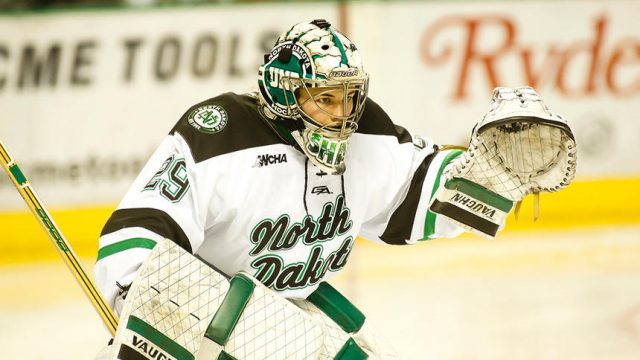The UND Women’s Hockey Program Lost $1.9 Million in 2016

UND's Lexie Shaw prepares for a goal attempt by Bemidji State University during the 2nd period of Saturday's game at the Ralph Engelstad Arena. Photo by Nick Nelson for the Grand Forks Herald.
There are a couple of ugly and inconvenient truths revealed by the University of North Dakota’s controversial decision to cut, among other sports programs, their popular women’s hockey team.
The first is this: Contrary to popular belief, campus athletics are no revenue boon to the schools.
Very few collegiate athletic programs in the nation operate in the black. Most lose money.
The second, derived from the first, is that sports programs made the cost of higher education higher for both taxpayers and students.
That is an unacceptable reality which must be addressed either by moving to make sports programs self-sustaining on their own revenues or moving them off campus entirely.
[mks_pullquote align=”right” width=”300″ size=”24″ bg_color=”#ffffff” txt_color=”#000000″]Athletic programs add to the already heavy financial burden of higher education.[/mks_pullquote]
I will earn myself no friends by pointing this out. This is a deeply unpopular point of view in our sports-mad culture, and I understand why. Sports are fun, and collegiate sports in particular draw talented and entertaining athletes into communities which could not possibly support professional sports teams.
Yet the truth remains. Athletic programs add to the already heavy financial burden of higher education.
But don’t take my word for it. Let’s go to the data.
The NCAA requires financial disclosures on sports revenues from participating schools which are helpfully compiled into a database by the folks at USA Today. The most recent year for which data is available is 2015.
Based on that information, we can see that at both UND and NDSU the sports subsidies (money drawn from general university funds and student fees) cost hundreds of dollars per student per year. This is money gobbled up by sports over and above what those programs generate in revenues through ticket sales, merchandise, concessions, media deals, etc.
You can also clearly see why UND is cutting sports programs while NDSU is not. At UND, those programs were gobbling up far more subsidies. Back in 2014 sports subsidies were costing UND nearly $900 per student.
The school has improved since then, but they are still significantly higher than NDSU:


And just to put an exclamation point on all this, let us look at the finances for the UND women’s hockey program for 2016. The document below, which comes by way of a lawmaker in Bismarck, shows that the had over $2.1 million in expenses in 2016 while generating just over $212,000 in revenue for a more than $1.9 million loss.
The loss is actually larger, too, because if you notice about $156,000 of the “revenue” for the program was subsidies from the university.
People will point to the revenue hit North Dakota took from falling commodity prices, something which has necessitated drastic budget reforms almost across the board from our state leaders, as a reason why women’s hockey had to go. But let’s be honest: It would be fiscally irresponsible to run a sports program losing that much money even state coffers are flush.
Our institutions of higher education are not intended to be host bodies for sports programs.
[scribd id=343523466 key=key-gaYhZByyhxFwtudoStg1 mode=scroll]




